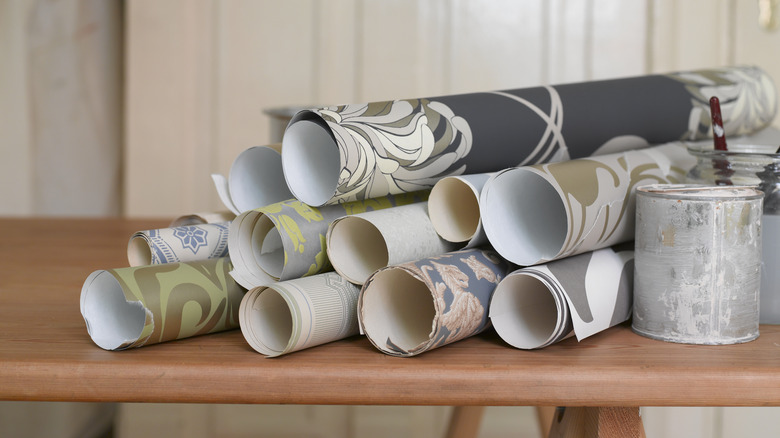The Cleaning Tool That'll Help Install Wallpaper
Installing wallpaper can often be a nail-biting event. It looks amazing when it's finally up, but you have to worry about all sorts of pitfalls along the way, such as not putting the wallcovering on straight, wallpapering corners, mismatching seams, and most frustrating of all, air bubbles forming. But a squeegee can help you with that last one.
Air bubbles form on wallpaper when small pockets of air get trapped inside. This can happen when you use the wrong amount of glue or paste or when you're hanging the wallpaper in a drafty (or unusually warm) room. Additionally, peel-and-stick wallpaper can be extra prone to bubbles as its adhesive material means it can't breathe as well as regular wallpaper, thus trapping more air than normal. All of these things can leave behind a collection of raised bubbles or ripples, which then become extra frustrating to smooth out. That's where a household squeegee comes in handy!
How to use a squeegee to get rid of bubbles
To use your squeegee to remove bubbles, first angle it so that it's not completely flat against the wall, and gently run it down the length of the paper. The bubbles will be pushed out to the end of the seam. Just be careful not to press too hard, or you may accidentally rip the wallpaper. You can also use varying squeegee sizes. If you have a large swath of bubbles, grab your bigger squeegee. But if you have just a few rogue bubbles here and there, a smaller one will be more helpful so as not to accidentally create more air pockets or rip the paper.
It's also useful to understand why wallpaper bubbles. If you're applying wallpaper that requires paste, make sure you use the right amount of glue. You don't want to add too little or too much, as unsightly bubbles can appear. Too much glue will create wet lumps, trapping the globs of adhesive in unsightly ripples. Too little glue will trap air between the wall and paper, creating bubbles and blisters. Make sure you follow the manufacturer's directions when applying the glue so that you get it just right. The temperature of the room can also encourage air bubbles — a room that is too warm, too cold, extra humid, or drafty can lead to increased bubbling.
How to apply wallpaper so it bubbles less
While the squeegee will help you smooth out any wayward air pockets, it's helpful to know how to apply wallpaper so that air bubbles don't even appear in the first place. Or, at the very least, how to apply it so that the sheet isn't riddled with them. If you're applying wallpaper that requires paste, you first need to choose a "paste the wall" wallpaper. That means it was printed on paper that allows you to put paste directly on the wall rather than the sheet. This makes the process much easier. Once you've picked your paper out, gently wash the wall with soap and water to ensure it's spotless. A clean wall helps the glue go on more smoothly. Then, apply the paste to the wall using a roller or paintbrush, taking care not to overload it with glue, and attach the paper from the top, brushing down as you apply. This should dispel any trapped air pockets.
Things are a little simpler for peel-and-stick paper. The adhesive is already attached to the panels, so you only need to attach them to the wall. But since the peel-and-stick fabric isn't breathable, you need to apply it extra slowly as not to trap any air. Use a squeegee to gently press it flat against the wall, pushing out any bubbles. If you get too many blisters in one spot, gently lift the paper back up and smooth it down with the squeegee.

